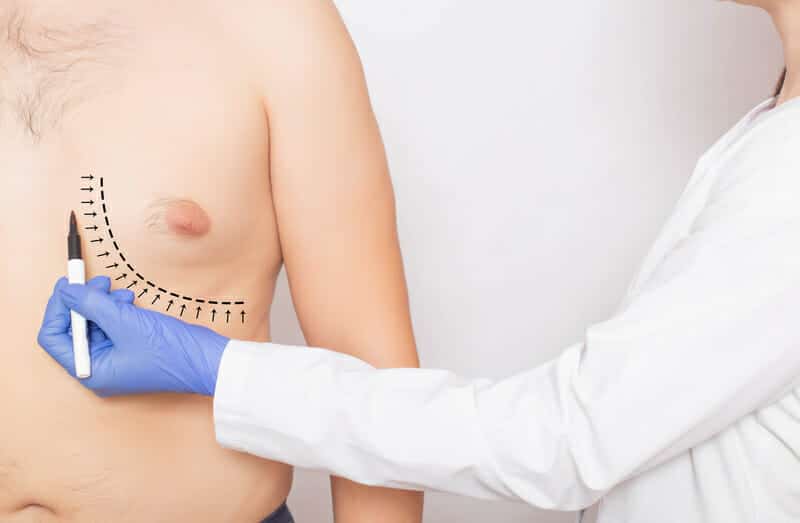Let’s get real: For a man, there’s nothing more unattractive than having gynecomastia, also known as “gyno”, “man boobs” or “b*tch tits”.
It cripples men to the point where they avoid dating or swimming in public pools.
But it’s no longer a rare condition: In Denmark alone, there is believed to be a 5-10x INCREASE in the incidence of gynecomastia between 1998 and 2017!
And based on comments left on medical forums, the men suffering from gyno are fully aware of how debilitating it can be to have an effeminate physique.
Yet there’s a silver lining in all of this: Gynecomastia can be safely treated and permanently eliminated if you follow a few key steps from start to finish while avoiding the mistakes made by 99% of men (and doctors).
By the end of this article, you’ll know exactly how to get rid of gyno once and for all.
Helping me write this definitive guide on a growing men’s health issue is none other than world-renowned board-certified plastic surgeon Dr. Joseph Cruise based in Newport Beach, California. Having treated well over 5,000 patients with an extraordinarily high success rate (including yours truly), it would be a crime to call him anything less than the foremost subject matter expert on gynecomastia.
I also have some experience in this matter as I’ve personally suffered from gynecomastia itself and had it fixed by Dr. Cruise.
Also, if you’re short on time and you want the Cliff Notes of this entire guide, please watch the two short summary videos below:
Table of Contents
ToggleWhat Is Gynecomastia?
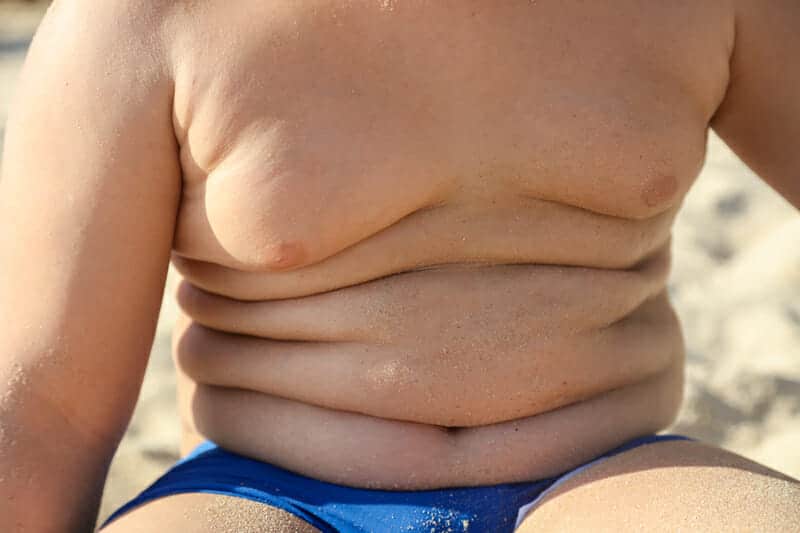
Much of what needs to be known about gynecomastia has already been written in The TOT Bible within Chapter 11, “Eliminating Gynecomastia Permanently”.
But I’ll tell you everything you need to know as succinctly as possible.
Gynecomastia can be defined as the over-development (i.e. swelling/enlargement) of male breast tissue that has been present for at least two years.
Or to put it more clinically:
“Gynecomastia is defined clinically as generalized enlargement of male breast tissue, with the presence of a rubbery or firm mass extending concentrically and symmetrically from the nipple, accompanied by histopathologically benign proliferation of glandular male breast tissue. It usually occurs bilaterally and is the most common breast condition in male”
(NOTE: This happens to females too but we’re going to focus exclusively on men for this article)
There are a wide variety of hormonal changes related to estrogen production that are responsible for this happening:
“Gynecomastia is a complex process resulting from many hormonal changes in the body. Estrogens strongly stimulate and androgens weakly inhibit mammary gland growth.
The imbalance between estrogen actions relative to androgen action at the level of breast tissue is believed to be the main etiology.
Various hypotheses have been put forth by a number of investigators explaining the etiology of gynecomastia, including: elevated estrogen levels; lowered free testosterone; abnormal testosterone-to-estrogen ratio; increased peripheral conversion of testosterone to estrogens by higher aromatase activity in periglandular fat and stroma; lower dehydroepiandrosterone sulfate-to-estrogen ratio; and altered local action or breast tissue sensitivity”
To be clear: We are specifically talking about an excess of breast gland tissue, NOT an excess amount of chest fat.
The latter case is what many experts refer to as “pseudogynecomastia”:
“Adipomastia, also known colloquially as fatty breasts, is a condition defined as an excess of skin and adipose tissue in the breasts without true breast glandular tissue. It is commonly present in men with obesity, and is particularly apparent in men who have undergone massive weight loss. A related/synonymous term is pseudogynecomastia.
The condition is different and should be distinguished from gynecomastia (“women’s breasts”), which involves true glandular breast development in a male. The two conditions can usually be distinguished easily by palpation to check for the presence of glandular tissue. Another difference between the conditions is that breast pain/tenderness does not occur in pseudogynecomastia.
Sometimes, gynecomastia and pseudogynecomastia are present together; this is related to the fact that fat tissue expresses aromatase, the enzyme responsible for the synthesis of estrogen, and estrogen is produced to a disproportionate extent in men with excessive amounts of fat, resulting in simultaneous glandular enlargement”
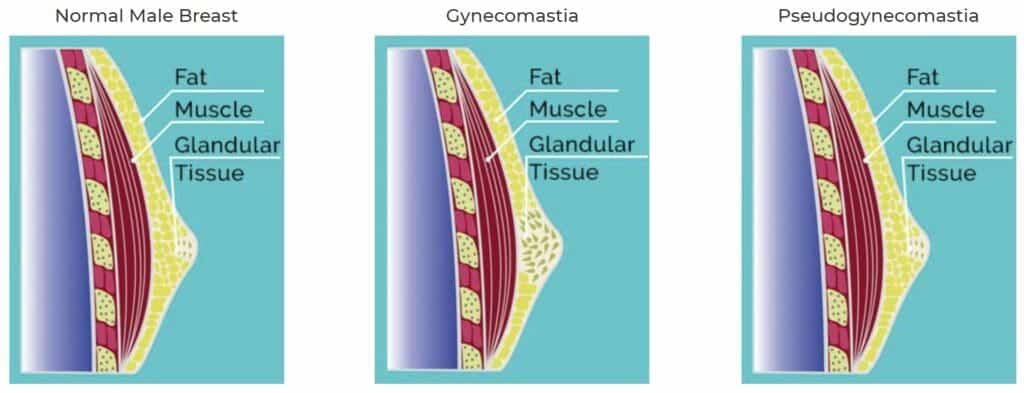
(Source)
For more info on the differences between these two conditions, I recommend reading the associated articles from Gynecomastia.org and CrazyBulk.
Gynecomastia can express itself at various stages of life including pre-puberty, puberty, and randomly at any age.
“In newborns, gynecomastia is caused by estrogen from the mother. Breast buds are common in baby boys. Breast buds tend to go away gradually by 6 months of age, but they can last longer in some babies.
In preteen boys, gynecomastia can also be caused by an estrogen-producing tumor. Breast buds are common during puberty. The buds may last up to 2 years, but they tend to go away within the first year.
In teen boys, gynecomastia is caused by the hormonal changes of puberty. Gynecomastia occurs in many boys during early puberty to middle puberty. It usually goes away within 6 months to 2 years.”
Despite gynecomastia being a non-life-threatening medical problem, it is treated with a “that’s just how it is” perspective and it will slowly emasculate millions of men into a lower quality of life.
Physical outcomes of gyno are few in number and include breast swelling, breast pain, and possible nipple discharge.
But the REAL damage comes from the grave effects on men’s mental health.
As Dr. Cruise has explained to me, the concerns around gynecomastia are far more than mere aesthetics concerns about having man boobs vs pecs:
“The emotional and psychological effects of this condition run deep and strip away self-confidence like cancer. It’s scary how unknown and mysterious this condition is. There is a psychological component to the suffering that should not be overlooked.
The world is more concerned about hiding it than learning about how to fix it. I feel a sense of obligation to shine a spotlight on gynecomastia, so that all men affected can seek treatment.”
The emotional and psychological trauma experienced by gyno suffers is devastating and it is heartbreaking to see how much the condition dramatically impacts their lives.
And bear in mind this isn’t the mere opinion of one doctor — we have more than enough clinical evidence showing how young and older men are negatively impacted by gynecomastia:
“Studies performed on adults and adolescents, with gynecomastia, have reported significant negative impact on psychosocial aspects, such as well-being, social functioning, mental health and self-esteem.
The main theory behind this correlation is that at the age of adolescence children solidify their body image, self-esteem and sexual identity.
The abnormal development of the breast tissue could, in this period, impact these domains and be an anatomic stressor. In a study by Li et al., 94.8% of patients reported psychological stress because of their gynecomastia”
Poor self-esteem, constant rejection, disordered eating, diagnoses of clinical anxiety and depression, outright emasculation, confused sexual identity… need I go on?
Unfortunately, most men will suffer from gynecomastia in silence because of how growing breasts negatively affects a man’s self-confidence.
With confidence completely stripped away, many men are too afraid to remove their shirts in public.
Causes Of Gynecomastia
Many people ask the question “Can you get rid of gyno without surgery?”, not taking into account the causes of gynecomastia and how it appears in the first place.
Sadly, gynecomastia is a LOT more common than you may believe:
“It has been estimated that 30–70% of males will experience gynecomastia at some stage in their life. Statistics from the USA show that 36% of adult young men and 57% of older men will have this condition in any of its different grades of severity.
It can therefore be deduced that it can be as common as one in every three adult men and one in every two elderly men.
Thirty to sixty percent of boys will experience pubertal gynecomastia but this is usually transient and resolves spontaneously whereby only 8% will have persistent pubertal gynecomastia after 3 years. Thirty to 50% of the cases present as bilateral gynecomastia (i.e., it can also present unilaterally). In Klinefelter syndrome (KF) gynecomastia is seen in about 80% of cases.”
It’s difficult to pinpoint the rise of this growing epidemic in Western society down to a singular reason due to how many factors can simultaneously increase a man’s chances of having it.
With the average male becoming more overweight over time, men are experiencing breast tissue growth that is made worse by poor nutrition, stress, additional body fat, inadequate sleep, and a combination of high estrogen and low testosterone.
Here’s just a small sample of them:
- The use of growth hormone-releasing peptides (as they concomitantly raise IGF-1, Cortisol and Prolactin)
- Alcohol (via liver damage that results in suboptimal hormone production)
- DHT-inhibiting hair loss drugs such as Finasteride
- Herbal products containing plant estrogens
- Various disease states (ex. liver disease, starvation, hyperthyroidism, male hypogonadism, type 1 diabetes, etc.)
- Many common medications and drugs (ex. HIV drugs, anti-anxiety drugs, ulcer drugs, select antibiotics and chemotherapeutics, heart medications, marijuana, etc.)
- Other hormonal imbalances, such as IGF-1
- Too much insulin in the diet from high carbs and simple sugars
There are many more for physicians and patients to be aware of, which are covered in two excellent scientific reviews (here and here).
Clearly, systemic inflammation can destroy both the insides AND the outsides of your body!
Six Types Of Gynecomastia
Gynecomastia can get complicated due to the many variations that exist:
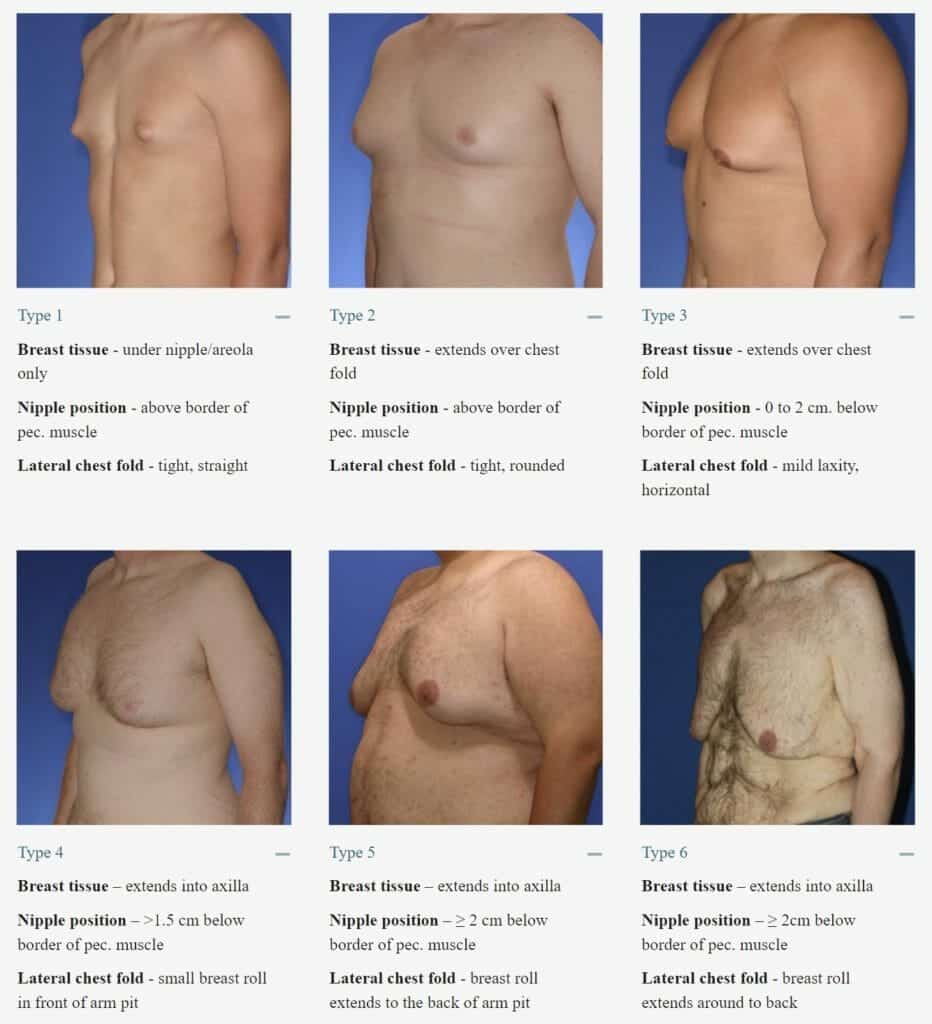
(Images provided by Dr. Joseph Cruise)
Don’t get overwhelmed — when you see a competent plastic surgeon who can fix gyno, as I’ll explain later, you’ll know which type you are.
But for most people reading this, and especially those on therapeutic testosterone, the first three types of gynecomastia are what concerns you most:
“Type 1 Gynecomastia – described by puffy nipples (with tight skin) and a predominantly visible gland;
Type 2 Gynecomastia – described by an increase in fat and a high gland-to-fat ratio (mild skin laxity with breast rounding)
Type 3 Gynecomastia – represented by an even higher gland-to-fat ratio (almost 2/3 fat, moderate skin laxity with nipple descent)”
As I wrote in The TOT Bible, these three types appear as a result of the surrounding skin losing its elasticity:
“Over time, the surrounding skin loses its elasticity. If there is no excess breast tissue left to hold, this loss of elasticity is relatively unnoticed.
However, if that skin is holding the weight of gynecomastia, it will eventually fail.
In this case, a patient has gone from a Type 1 or 2 (which requires incisions that are not noticeable) to Type 3 or Type 4 (which requires progressively higher levels of skin tightening and hence, longer incisions are necessary).”
With this information in hand, let’s go over what doe NOT work for removing gynecomastia so we know how to reverse gyno properly.
Gynecomastia Treatment Without Surgery: Does It Work?
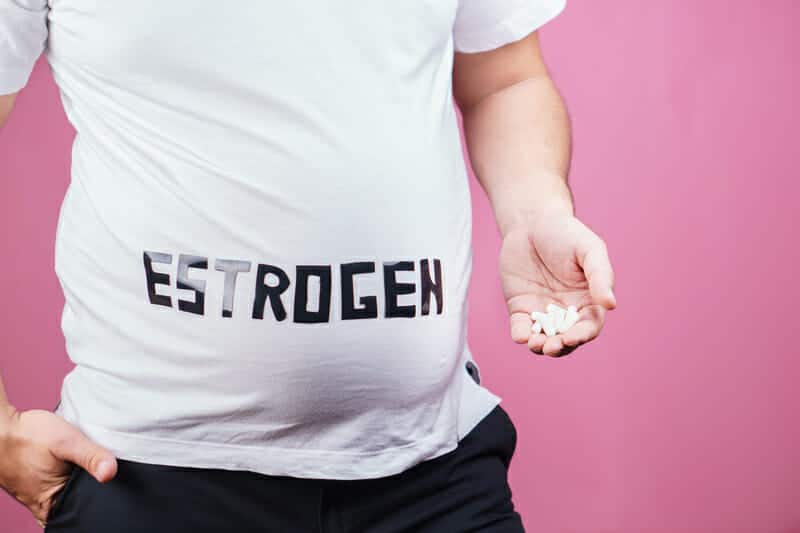
Before I talk about how to get rid of gyno, you have to be well aware of the solutions which simply fail to treat the problem of gynecomastia.
The ineffective fixes fundamentally boil down to a complete misunderstanding of how gynecomastia works.
Concealment And Avoidance
This option involves exactly what you think it does: Helplessness through the acceptance of what you will soon discover is entirely treatable.
I’ve written about this before, but to summarize:
“Patients usually wear two shirts at the same time and have the outer shirt oversized to make sure their chest contour isn’t revealed. No tight shirts or white shirts. They also slightly hunch their shoulders to cover the chest, which can cause serious medical problems with shoulders, back, and posture in the long-term. Plus, men also often pull at the shirt to ensure it doesn’t cling to their chest.”
Dr. Cruise has referred to this as the “Gynecomastia Routine” as it reflects how gyno suffers dress to hide, rather than to impress.
You can obviously imagine how this emasculates even the most masculine of men, forcing them to avoid the joys of life so they don’t have to put themselves in a potentially revealing situation.
Which naturally leads to these unfortunate men becoming bullied, teased, and sometimes reaching the point of considering suicide.
No going to the beach without a shirt on, missing out on pool parties, never removing your shirt at the gym… it’s not a life worth living.
To make matters worse, you have articles on the Internet that actively ENCOURAGE using specialized shirts to hide gyno:
“Gynecomastia compression shirts are made specifically for men dealing with this condition and come in t-shirts, tank tops, vests, and even areola sticky’s that cover puffy areolas. You can wear the vests or tank tops under your favorite sweater or button up to hide the appearance of gynecomastia, or wear the t-shirt on its own.”
“They use nylon and spandex to flatten your stomach and torso, creating a flattering silhouette and remaining practically invisible when worn under another shirt. This will increase your confidence in work meetings, out on dates, or even running errands out of the house. Gynecomastia compression shirts are an immediate answer to the insecurity that can arise from dealing with this condition”
If anybody tells you this and truly believes it, run as fast as you can in the opposite direction!
Don’t let useless medications, horror stories of bad surgery outcomes, contradictory opinions, and misinformation online be your excuses for never getting rid of gynecomastia
Failure #2: Living A “Clean” Lifestyle
Now, I do want to start off this section with a caveat from Dr. Cruise himself:
“Unquestionably, the single best way to ‘treat’ gyno is to avoid it altogether, or minimize it before it becomes a problem.”
“I have zero doubts about the positive effects of optimizing your testosterone under the supervision of an experienced physician, and it’s certainly possible to lose fat in (and around) the chest area by building muscle. But it’s only in rare instances where I’ve seen this achieved in men with previous existing conditions of gynecomastia.”
Ideally, therapeutic testosterone is the non-surgical remedy that treats gyno as increasing the testosterone levels in the body under professional medical supervision helps you lose fat around the breast area (and turn it into muscle over time when combined with exercise).
This is something you should be doing regardless of whether you have gyno or not.
Eating a clean diet, training intelligently and doing cardio, sleeping well at night… the three basic tenets of good health and naturally increasing muscle mass through lowering inflammation and visceral body fat.
In a technical sense, biohacking weight loss would be “gynecomastia treatment without surgery”.
Yet there are some caveats worth mentioning which will show you why being fully optimized MAY NOT lead to the elimination of gynecomastia.
First, some men will be oversensitive to the conversion of testosterone into DHT, leading to mild gland growth around the nipple:
“Optimal T levels should not increase gyne. In fact, the improved T:E ration may help. However, there is the sub set of men who are so sensitive to T and its conversion to DHT that they will experience mild gland growth. The positives, however, are so overwhelming that the tradeoff is so worth it.
Even for the body builders who I treat so often; patients that abuse anabolics with total disregard for how they are doing it and what is really happening to their body, even these patient’s get a “free pass” of sorts considering that once the gland has been properly removed, it can never come back. They will damage their body in other ways but gynecomastia is not one of them.”
(As you’ll see later on in this article, this is likely what happened to me when I suffered from gyno)
Second, getting your health in order will only eliminate your “b*tch tits” if you are suffering from the condition of “pseudogynecomastia” mentioned earlier.
If what you believe is gynecomastia turns out to be high body fat levels in the chest combined with a lack of chest muscle, you may be one of the lucky ones.
But if not, and living a fully optimized lifestyle doesn’t fix your problems, you’ll need to get serious and start exploring the proven fixes for getting rid of gynecomastia.
Ancillary Medications
Here is where things can go seriously wrong; at best your gynecomastia will remain as it is, and at worst you will damage your hormonal health to a significant degree while still not knowing how to get rid of gyno.
So make sure you’re well aware of these commonly suggested treatments and why you should avoid them…
Aromatase Inhibitors (AIs)
Many doctors operate under the false belief that using AIs (Arimidex, Aromasin, etc.) to block estrogen as a means of suppressing gyno, slowing its progression, or eliminating it altogether.
But long-time readers already know about the dangerous effects of artificially lowering estrogen levels.
Here are the takeaway bullet points explaining why AI use is ill-advised:
- AIs do nothing but temporarily mask the issue, sometimes temporarily suppressing the expression of the inflamed glandular breast tissue, which is guaranteed to come back or express again once you stop using the medications
- Gynecomastia is a genetic condition (more on that later), and thus those pre-disposed to it will find AIs to be useless
- The long-term adverse effects are numerous: Lower bone mineral density leading to fractures, cardiovascular damage, sexual dysfunction, cognitive decline, and much more
- You’re NOT trying to lower your estrogen when you’re on therapeutic testosterone; You’re trying to lower your inflammation and your visceral body fat because lowering your estrogen is actually reducing the positive effects that estradiol confers to your biological systems when cleaved enzymatically from therapeutic testosterone.
- Estrogen will find its natural level when a man is on therapeutic testosterone seeking optimization. What this means is some men who are inflamed and have too high a body fat are gonna have their estrogen level ‘appear to be higher’ than the standardized laboratory range values. Their Doctor will then have to find a balance where they don’t have negative symptoms or side effects-which was never from the estrogen level anyways. These symptoms and side effects normally stem from their systemic levels of inflammation brought on by high levels of visceral body fat and a poor diet and lifestyle.
Not only does suppressing your estrogen levels have no effect on getting rid of gynecomastia in the big picture, but it also ends up killing both your short and long-term health!
Selective Estrogen Receptor Modulators (SERMs)
The issues with SERM use (Clomid, Toremifene Citrate, Novaldex, Raloxifene, etc.) are largely the same as the ones you’ll see with AI use.
So let me reiterate what I previously said…
Often times SERMs do offer some glandular tissue suppression (i.e. reduction in the size of the swollen breast tissue), but the suppression is not permanent and the gyno will “flare up” again once you stop using them.
The majority of physicians who prescribe SERMs for gynecomastia fail to understand its etiology (i.e. genetic causes) and as such the medications will never offer a final solution.
Thus, the overprescribing of SERMs is rampant and clinically incorrect (Not to mention the massive and widespread misuse in the bodybuilder/bro communities while ‘on cycle’).
Especially for adolescents who suffer from gynecomastia:
“Twelve boys, aged 12 to 19 years, with persistent gynecomastia were treated with the antiestrogen, clomiphene citrate, at a dose of 50 mg/day by mouth for one to three months. The mean breast size decreased by 0% to 36%, with only five boys experiencing a reduction of greater than 20%.
Five boys subsequently required reduction mammoplasty. Levels of urinary gonadotropins, serum testosterone, and estradiol increased significantly during therapy.
Since the ratio of testosterone to estradiol remained unchanged during treatment, the antiestrogen effects were achieved primarily at the level of breast tissue. Clomiphene citrate in a dose of 50 mg/day resulted in only small decreases in persistent pubertal gynecomastia and was not a satisfactory medical therapy for the condition.”
But overall, all you end up doing is causing great harm to your health in the long term as suppressing estrogen, systemically or selectively, compromises your biological systems in numerous ways.
Stop using SERMs and AIs because they don’t work anyway… if you have gyno, you’ll soon see why surgical removal is the only real way out of your predicament.
Androgenic/Anabolic Steroids (AAS)
This small section is especially important for the bodybuilders reading this article.
While there are numerous downsides to using high levels of AAS, one of them just so happens to be the exacerbation of gynecomastia.
In short, using supra-physiologic dosages of androgens and way to high dosages of AI’s/SERM’s to block what is perceived as the “symptoms” of excess aromatization (water retention, bloat, etc.) is extremely harmful to your biological systems and especially your vascular, neurological and bone health.
Using supra-physiological levels of AAS/AI’s/SERMS or anything that changes your baseline hormone levels can cause the increased expression of the gynecomastia condition via inflaming the breast tissue leading to the growth of fatty cysts or swollen tissue-especially in the men genetically predisposed to this happening.
High dose Androgens and AI’s/SERM’s is a guaranteed recipe for disaster.
Getting Rid of Gynecomastia: Proven Treatments
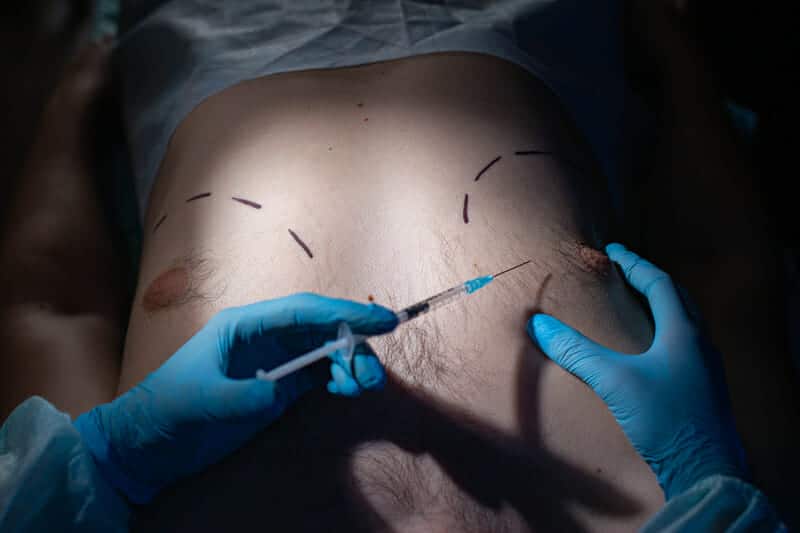
The good news about how to get rid of gyno is that the verifiably effective solutions are few in number.
So you either choose to do them or you do not — no grey area really exists here.
Genetic Screening
* Getting genetically tested to see if you are genetically predisposed (shoutout to Dr. Anthony Jay and his DNA services)
Believe it or not, there is indeed a genetic component to gynecomastia.
I talked about this in great detail with Dr. Anthony Jay in a recent Totally Optimized Tuesdays broadcast I did:
I also recommend watching two of the premium webinars I did with Dr. Jay (here and here) for more in-depth discussions about the genetic origins of gyno.
But to summarize the important talking points, the two important genes you need to know about are CYP1B1 (cytochrome p450 Family 1) and CYP19 (aromatase cytochrome p45019).
Here’s the best explanation I could find for how these genes may be responsible for the development of gynecomastia:
“Estrogen effects on the breast might be the result of circulating estradiol levels or locally produced estrogens. Aromatase P450 catalyzes the conversion of the C19 steroids, androstenedione, testosterone, and 16−α−hydroxyandrostenedione to estrone, estradiol-17β, and estriol.
As such, an overabundance of substrate or an increase in enzyme activity can increase estrogen concentrations and initiate the cascade to breast development in females and males.
For example, in the more complete forms of androgen insensitivity syndromes in genetically male (XY) patients, excess androgen aromatizes into estrogen resulting in not only gynecomastia, but also a phenotypic female appearance”
…Over expression of aromatase in male transgenics causes increased mammary growth and histological changes similar to gynecomastia, an increase in estrogen and progesterone receptors, and an increase in downstream growth factors such as TGF-beta and βFGF”
Head on over to the end of this article for specific action steps on how you can determine your own likelihood of developing gyno (or if you already have it).
Surgical Removal
Some men will continue to have sensitive and puffy nipples despite using therapeutic testosterone and “doing all the right things” (these men are usually over-sensitive to an even balance of testosterone and estrogen).
Whether it’s suffering from enlarged breast glands since the onset of puberty, or having self-inflicted gyno due to using supra-physiological doses of anabolic steroids and/or testosterone, several processes occur that make gyno impossible to get rid of through lifestyle interventions.
Can you get rid of gyno without surgery? Only in the most extreme cases and even then you shouldn’t assume you are an outlier.
Thus, the only true be-all, end-all solution for how to get rid of gyno is having the swollen tissue surgically excised by a competent surgeon who is thoroughly experienced in doing so.
More specifically, according to the American Society of Plastic Surgeons:
“When patients come in with a complaint of gynecomastia, they usually complain about lumps in their breasts with or without excess fat in the breasts.
Surgery to remove the breast tissues usually involves liposuction of the excess fat, surgical removal of the excess glandular breast tissue through an incision in the margin of the nipple-areolar complex and/or skin excision (in very large male breasts).
It is important that your surgeon perform a proper physical exam of your breasts to confirm gynecomastia and rule out the suspicion for male breast cancer.”
I cannot emphasize the importance of choosing a surgeon who understands the importance of removing ALL of the inflamed glandular breast tissue and knows how to do this correctly.
Many surgeons do not understand how delicate this surgery is — every last bit of the glandular tissue MUST be removed from the duct networks if gyno is to be gone forever.
Doing so requires immense technical skills, practice-based experience, and a deep understanding of what the patient wants.
I’ve been in contact with numerous men who end up having multiple surgeries to correct this condition due to a lack of physician awareness, only for the gyno to present itself again.
As a result, they end up with more unsightly scars and a condition that appears to be permanent in nature.
Therefore, if you are a man suffering from the psychologically debilitating and painful affliction of gynecomastia, it is mission-critical to schedule a consultation with a doctor who specializes in glandular tissue.
IT IS the ONLY full-proof fix when all non-surgical methods ultimately fail to work.
The bad news is this: The highly specialized and nuanced surgical procedure of gyno removal is “no man’s land” for many plastic surgeons who are both unwilling and unable to do it.
The good news is there ARE physicians in the world who can get the job done… and Dr. Joseph Cruise is unquestionably one of the few who knows how to reverse gyno properly, as you’ll see in my personal story below.
My Personal Story With Removing Gynecomastia In 2016
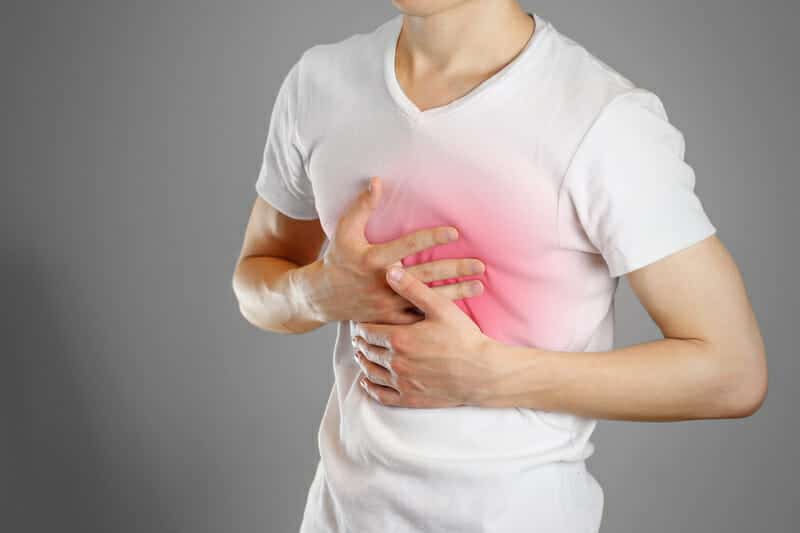
This section is largely a re-write of a major section in Chapter 11 of The TOT Bible but it’s important to understand where I’m coming from.
So here’s what happened to me several years ago…
After 15 years of successfully using therapeutic testosterone without any nipple sensitivity whatsoever, I was shocked to find that in 2015 I had suddenly developed glandular gynecomastia in my right breast.
I was genetically predisposed to having it in hindsight, but there were likely a number of causes contributing to the condition (insulin levels, cortisol levels, IGF-1 levels, life stressors, hormonal fluctuations, etc.).
It became visually apparent to myself and others when I wore any kind of tight-fitting clothing, and it was physically painful to hug my wife or children.
I spent a year attempting to use AIs, SERMs, and other ancillary medications to treat my gyno with no success whatsoever.
Come May 2016, I decided to go under the knife of Dr. Cruise and have it surgically removed.
I was very fortunate to have picked the right man for the job based on my online research.
And even more fortunate to have had a successful surgery:
- The surgery was done under local anesthesia as an outpatient procedure
- The entire procedure was easy and finished in just one hour
- I returned to work within 4 days following the surgery
- A month later I was back in the gym and training intensely
Take a look at the before/after pictures below to see for yourself:
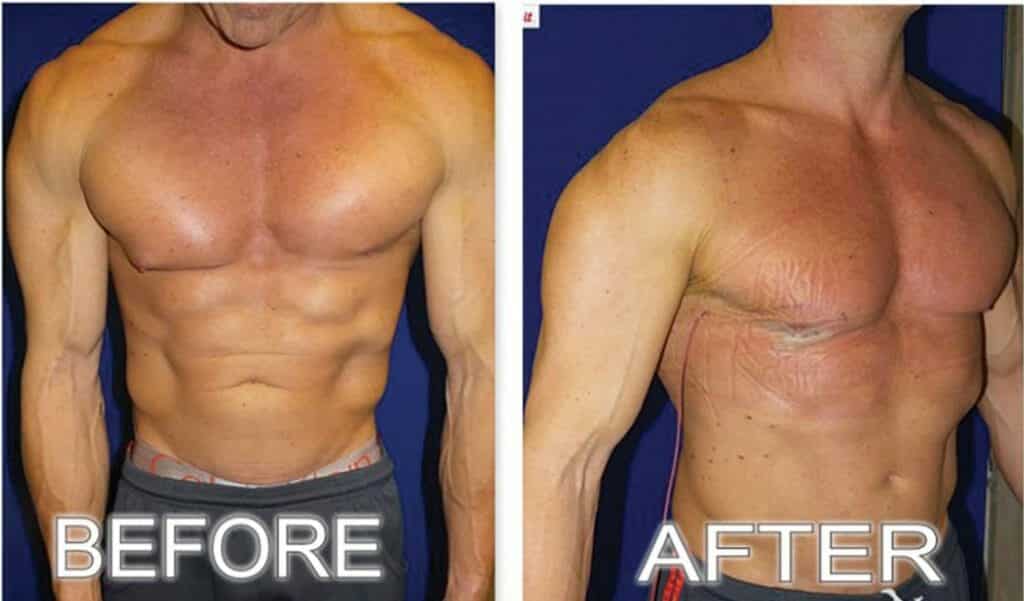
There is no reason to suffer in silence any longer, or to be ashamed… which is why myself and another gentleman were more than happy to leave a video review:
For even more visual examples of Dr. Cruise’s success treating all six types of gynecomastia, his website has numerous before/after photos showing the remarkable changes undergone by former gyno sufferers.
However, in full transparency, I do want to talk about some of the downsides of surgery…
First off, the surgery can prove to be extremely expensive for the majority of patients who choose this option.
As Dr. Cruise mentioned in a reply to the video I just posted:
“…the cost depends on the type/severity of gynecomastia. Mild cases range between $6,500-$6,900 when performed under local anesthesia in the office [per breast]. General anesthesia is an option, but will increase the cost.
You can visit my website, which has the price ranges for each type. You can apply for financing through one of the financing companies we work with.
If you don’t qualify for financing, we can certainly discuss setting up a payment plan where you send in money every month (or whatever we determine works best for you) and once you are paid in full, you can schedule the surgery”
Unless your gyno is caused by a condition such as Klinefelter’s Syndrome, the procedure is regarded as “cosmetic” by most insurance companies and it will not be covered.
Second, there are numerous precautions you must adhere to before and after the surgery.
Here’s what one surgeon advises patients to do pre-surgery, which seems to mirror what many others recommend:
- Certain substances must be abstained due to their ability to increase the risk of bleeding
- No consumption of food 8 hours before surgery, and no liquids up to 3 hours before surgery
- Hair in the chest and under-arms area must be completely removed
And as for what needs to be done post-surgery, your life may be limited for a short period of time:
- No shower, baths, or any aquatic activity for 24-48 hours after the surgery
- No driving for 24 hours following the surgery (someone will have to accompany you)
- No exercising for 2-6 weeks following surgery to allow the incision to heal.
- Ancillary medications (antibiotics, pain relievers) may have to be taken for a few weeks
- Tapes/compression garments covering the wound will need to be worn and/or replaced every 10-14 days
- Possible side effects – breast pain/swelling, changes in sensation around the nipple, scars that take several months to disappear
These recommendations are not set in stone and vary widely depending on the physician performing the surgery.
I was personally back training in the gym at about 4.5 weeks post-surgery and performing cardiovascular activity after 10 days or so.
Therefore, make sure to follow their instructions to the letter for best results (faster recovery, minimization of side effects, etc.).
Gynecomastia Surgery Recovery With Therapeutic Peptides
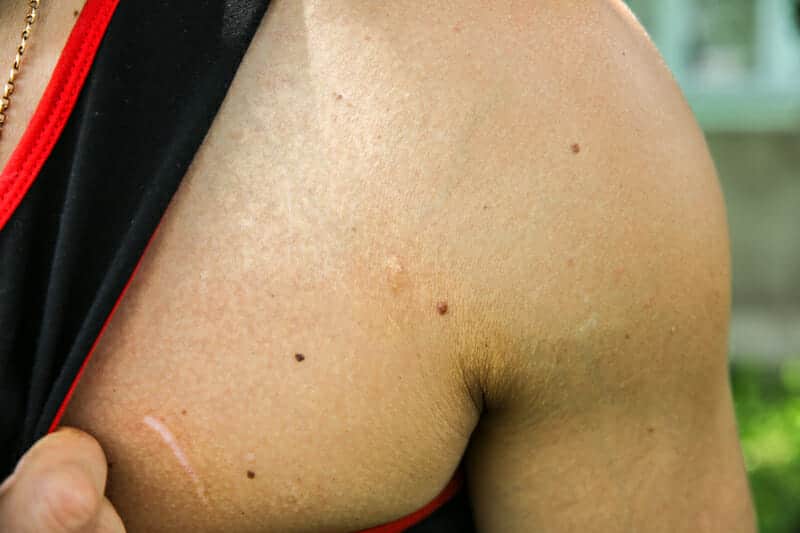
I was originally scheduled to have outpatient surgery on October 24th, 2019 for removing gyno from the nipple area on my left breast.
And given my success 3 years earlier, who better to go to than Dr. Cruise himself?
But this time was different: I wanted to document an experimental gynecomastia surgery recovery protocol using advanced, cutting-edge peptides and supplements to massively accelerate the cellular healing and regeneration process post-operation.
I even announced this intention publicly to my email subscribers and my YouTube audience:
The goal was to cut the normal post-surgery healing period of 4-6 weeks down to a mere 2-3 weeks.
Unfortunately, the surgery was canceled at the last minute due to an injury Dr. Cruise sustained in martial arts training.
Since then the gyno has miraculously disappeared.
I have this protocol saved and ready to be used with Dr. Cruise should the future need arise.
A protocol I heavily credit my business partner Nick Andrews and Ryan Smith of TruDiagnostic (two of the smartest peptide chemists on the planet) for formulating.
I KNOW this works as well as intended and it will serve as a beacon for millions of men around the world who will go through the gynecomastia surgery recovery process.
So without further ado, here it is!
NOTE: All the mentioned peptides for weight loss and injury healing can be sourced from Limitless Life Nootropics and you can get 15% off your purchase with code JAY15
Day-to-Day Stack For Fully Optimized Health
I took the following three agents before, during, and after the surgery on a daily basis:
- Scrotal testosterone cream: 200 mg per gram applied in the morning
- Armour Thyroid (Dessicated): 60 mg in the morning and evening
- Metformin: 1000 mg in the morning and evening
Those of you who are long-time readers will recognize this trio as my own-approved optimization healthcare stack!
And where possible, I will also slip in sun-gazing and grounding when time allows during the day.
Pre-Surgery Loading Phase: 3 Days Before The Surgery
This is what I took 3 days before the surgery and on the day of the surgery.
MORNING – PEPTIDES
- 5-Amino 1MQ: Three 50 mg capsules upon awaking
MORNING – SUPPLEMENTS
- Carbon 60: 1.25 teaspoons (I recommend getting it from Purple Power)
- J-Flex9: 3 capsules
- Grounding: 30 minutes with my bare feet on earthen soil
EVENING – PEPTIDES
- BPC-157: 260 mcg injected subcutaneously
- TB-500: 7 mg injected subcutaneously
- Tesamorelin: 1 mg injected subcutaneously
- GHK-Cu: 0.25 mL of a 3% ointment applied topically to cover the surgical incision area
EVENING – SUPPLEMENTS
- J-Flex9: 3 capsules
- Grounding: Ideally you want to be sleeping on a grounding mat
Post-Surgery Healing Phase: 28 Days After The Surgery
This is what I took on the day after the surgery and continued for 27 more days.
MORNING – PEPTIDES
- 5-Amino 1MQ: Three 50 mg capsules upon awaking
- BPC-157: 260 mcg injected subcutaneously
- Tesamorelin: 1 mg injected subcutaneously
- GHK-Cu: 0.25 mL of a 3% ointment applied topically to cover the surgical incision area
MORNING – SUPPLEMENTS
- Carbon 60: 1.25 teaspoons
- J-Flex9: 3 capsules
- Grounding: 30 minutes with my bare feet on earthen soil
EVENING – PEPTIDES
- BPC-157: 260 mcg injected subcutaneously
- TB-500: 1.25 mg injected subcutaneously
- Tesamorelin: 1 mg injected subcutaneously
- GHK-BPC Combo Cream: 2 mg and 2 mg / mL applied topically to cover the surgical incision area
EVENING – SUPPLEMENTS
- J-Flex9: 3 capsules
It goes without saying that you should have enough quantity of peptides and supplements for both the pre-surgery and post-surgery phases well in advance.
And it should be obvious that combining this with the surgery means you need to be in good financial standing.
What You Can Do To Treat Gynecomastia Today
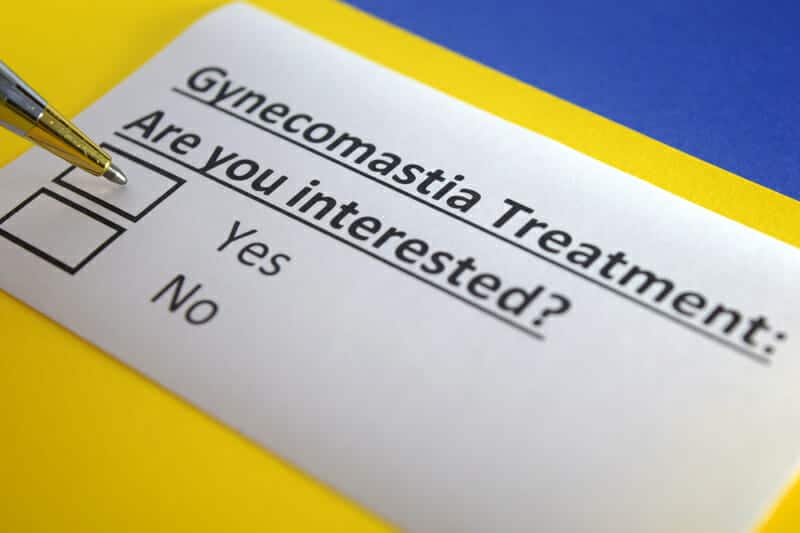
Knowing what you now know after reading this entire article from start to finish, I’m going to leave you with some actionable items you can get started on today to eliminate gynecomastia for good.
Men need to physically recover from this condition while treating the psychological component at the same time.
There is no reason that modern-day men dealing with the shame and taboo of not knowing how to get rid of gyno shouldn’t be able to work with elite physicians who can treat and eliminate the problem.
Step #1: Get Educated On Gynecomastia
There are a few amazing resources worth your time if you are serious about getting rid of gynecomastia.
Gynecomastia.org – probably the most comprehensive collection of information about gyno, an international hub full of educational content and discussion forums that’s been around since 1986.
LAGynecomastia.org – A useful resource provided by Dr. Cruise for anybody who wants to learn more about what is involved in the surgical removal of gyno.
I also have the world’s best podcast on gynecomastia with Dr. Cruise, and several older videos that address the subject of gyno treatment in greater detail:
Lack of information or education about how to get rid of gyno is no longer an acceptable excuse!
Step #2: Make Sure Your Health is Fully Dialed In
This step is straightforward and doesn’t need much more explanation.
All of my free articles on this website are jam-packed with everything you could possibly want to know about fully optimized health.
If you need to lose body fat ASAP, The Metabolic Blowtorch Diet is a great place to get started and Guaranteed Shredded will help you want to accelerate the process (Don’t forget about muscle growth!)
The TOT Bible and Living A Fully Optimized Life are my “magnum opus” books and cover the subject of male health across every domain imaginable.
Physicians such as Dr. Rob Kominiarek and Dr. Scott Howell are available to help you get your hormones balanced at the right levels.
Step #3: See If You Are Genetically Predisposed To Suffering From Gynecomastia
You owe it to yourself to know if you happen to express the gene(s) responsible for the development of gynecomastia.
Go to a website like Ancestry or 23andMe and get a comprehensive screening of your DNA.
Then, have Dr. Anthony Jay look over your DNA and tell you if you have the gyno gene(s) or not.
You’ll also learn about other important health factors such as your muscle fiber type, which will allow you to train optimally for your genetics instead of wasting time on unproductive training programs.
Step #4: Work With A Top-Tier Surgeon To Have Gynecomastia Surgically Removed
If you are a man suffering from the psychologically debilitating and often painful affliction of gynecomastia, I highly recommend scheduling a consultation with a doctor who specializes in the full removal of the glandular tissue.
My personal recommendation is none other than Dr. Joseph Cruise and his clinic based in Newport Beach, California.
Please mention that ‘Jay Campbell sent you’ so they may offer you preferred financing and payment options.
And as always…

